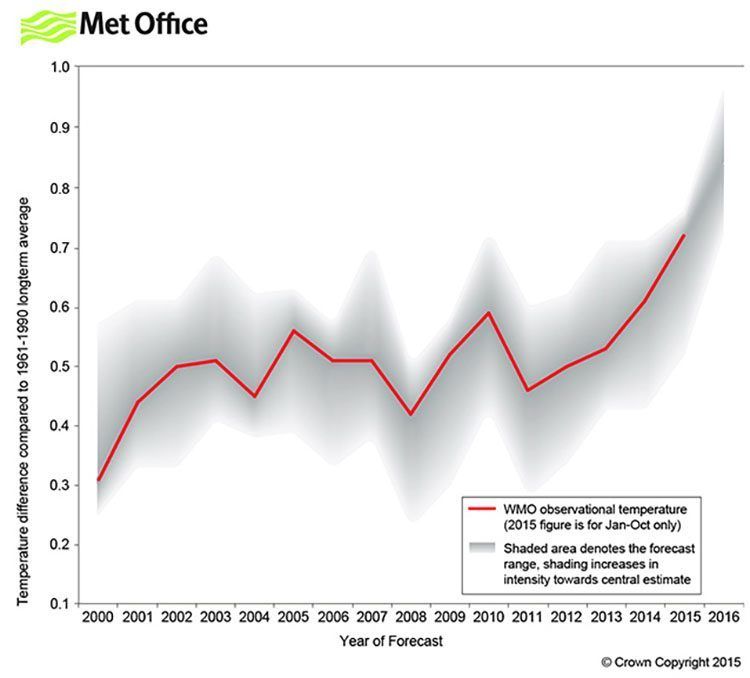

Last year topped the chart as the warmest year in the modern record, according to data released Wednesday by the world’s top meteorological agencies.
Global temperature in 2015 was 0.75C above the 1961-1990 long-term average and a full 1C above preindustrial times, according to official figures from the UK’s Met Office.
Rising greenhouse gases and a “small contribution” from the El Niño in the Pacific combined to cause the record temperatures in 2015, the Met Office’s Prof. Adam Scaife tells Carbon Brief.
There is unlikely to be any respite—scientists expect 2016 to be even warmer than 2015, says Scaife.
“Overall, we expect El Niño to contribute around 25 percent to what will most likely be a new record global temperature in 2016.”
The two major U.S. meteorological agencies—National Aeronautics and Space Administration (NASA) and the National Oceanic and Atmospheric Administration (NOAA)—also confirmed 2015 as the warmest year on record today. Dr Gavin Schmidt, director of the NASA Goddard Institute of Space Studies, said:
“2015 was remarkable even in the context of the larger, long-term warming trend.”
In a joint summary with former head of NASA GISS, Dr. James Hansen, Schmidt says 2015 global temperature “smashed the prior record” and “should practically terminate” discussion of any slowdown in the pace of global warming.
Updated: How 2015 became hottest year on record | With data from @metoffice @NASA @NOAA https://t.co/eMKs4UPGuE pic.twitter.com/7y7JmDqVOX
— Carbon Brief (@CarbonBrief) January 21, 2016
Forewarning
Each year, the world’s major meteorological organizations calculate the global average surface temperature. It’s one measure of how the world is responding to greenhouse gas emissions.
Well before the end of 2015, it was looking likely that it would end up as the hottest year on record by quite some margin.
In an announcement timed to coincide with the UN climate talks in Paris in early December, the World Meteorological Organization (WMO) said it expected 2015 to be the first year to see global temperatures rise 1C above preindustrial levels.
The Met Office predicted at the end of 2014 that 2015 would be among the hottest years on record, with global temperature likely to fall within the range 0.52-0.76C above the 1961-1990 average. The actual observed temperature anomaly of 0.75C is at the upper end of that range.
From this point of view, yesterday’s news that 2015 was the hottest year on record comes as no great surprise. Perhaps what’s most remarkable is how much hotter it has been.
Levels of Confidence
Measuring global temperature is complicated. Scientists’ estimates come with a range of possible temperatures either side of a central figure, to reflect that uncertainty.
While yesterday’s announcement puts 2015’s global temperature at 0.75C above the 1961-1990 long-term average, the scientists say it could realistically be as low as 0.65C or as high as 0.84C.
(Note: The Met Office traditionally uses a 1961-1990 baseline, rather than the less well-defined “preindustrial” level. Where it uses term ‘preindustrial’, this refers to the 1850-1900 average.)
When it comes to temperature rankings, what matters is whether the difference between individual years is more or less than the range of uncertainty. If it’s more, scientists can be confident one year was warmer than the other. If it’s less, they can’t say for certain either way.

 233k
233k  41k
41k  Subscribe
Subscribe 

